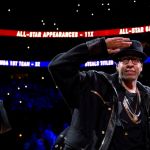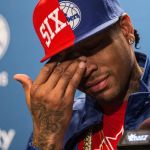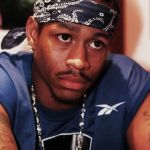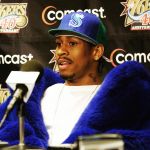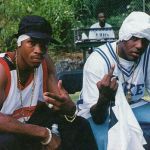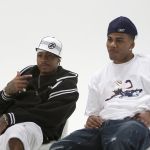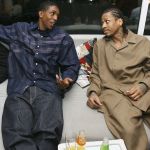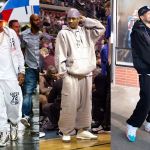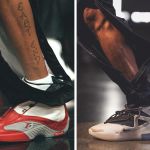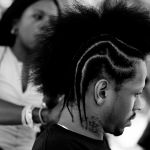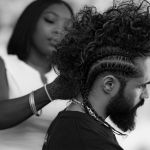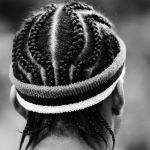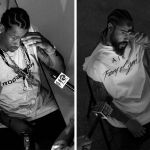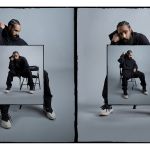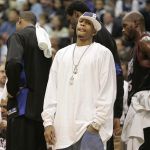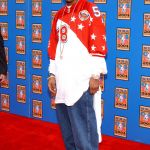
Allen Iverson and the evolution of streetwear
From Hampton to the introduction of the ''dress code'', why AI has been so influential for today's NBA
April 7th, 2020
On June 6, 2001, just few hours before his 26th birthday, Allen Iverson showed up in the Staples Center press room for the NBA Finals post-race 1 conference. He has just put 48 of them at the Los Angeles Lakers, in one of the most sensational upsets in the history of the Finals, with an iconic play that will help bring Tyronn Lue into the story from the wrong start, regardless of the result of that series: «All that it is important to leave everything you have on the field: it is the only way you have to go back to the locker room and be able to look at yourself in the mirror without regrets ». He wears a pair of sunglasses that he would not have disfigured in the Matrix, a Philadelphia Eagles shirt of at least two larger sizes, a black bandana with his logo - the same that appears on his signature shoes by Reebok -, a showy crucifix d silver that matches the diamond on the right lobe: an unmistakable style for what, at that moment, is the most famous athlete in the world.
A style that, following the terrible "Malice at The Palace", the commissioner David Stern would have officially banned in October 2005, imposing on the players a dress code based on a casual business style in opposition to the iconography of the ghetto cleared through bandanas, snapbacks, superfluous jewelry and low-rise jeans. The first voice out of the chorus - along with those of Stephen Jackson and Paul Pierce - against Stern's initiative would, of course, have been precisely that of AI: "This way of dressing has characterized my generation. Just because you decide to have a guy put on a tuxedo doesn't mean he'll become a good guy. You can have a killer wear a nice suit, but he will always remain a killer. "
It could not have been otherwise. Since his debut in the league, Iverson had changed the perception of the term icon associated with an NBA player, in a representation that transcended the field and what he was able to do inside: those braids, those tattoos to cover almost entirely the arms and the rest of the body, that typical look of someone who is not afraid of anything because he has already seen them all in the popular neighborhoods of Hampton, were the salient features of a new epitome of the cult. Iverson was one of the most recognized and recognizable players in the league not so much for his way of playing, but for being a pop icon much closer to the reality of reference of the average NBA enthusiast: for the fans - especially the younger ones and above all African Americans - but also for many other players of that generation, it was in fact much easier, natural and immediate to recognize oneself in the "thuggish" style of "The Answer". Because it was also theirs in everyday life.
A cultural primacy that Iverson has always paid dearly for, with the prejudices against him that often went beyond his actual responsibilities: «Do not imagine how many times in the past I have found myself having to justify myself for my clothing and for my hair. People said that I didn't dress like a professional and that, therefore, I could never have behaved as such. As if someone had ever committed a crime just because he wore his hair in a certain way. Ok I'm young, I'm black and I dress like that to do what? Simply to go and do what I know how to do », he will write in 2018 on The Players'Tribune, almost as if he wanted to claim what being always and only himself meant, even in the look perfectly corresponding to the stereotype of the" bad guy " protagonist of the video clips of Notorius BIG, 2Pac, André 3000, Coolio and Redman.
"When my career is over I want to be able to look in the mirror and tell me that I did it my way," he said one day in response to those who continued to want to include him in a category of players to whom he could not, or rather did not want, belong : because he simply wanted to be Allen Iverson, on and off the pitch, without the need to follow any model and without having to become one himself. And that look was a way to remind everyone. But if on one hand AI did not feel the need to be an inspirational model, on the other hand he did not know that it would become not only from a sporting point of view but also from a stylistic point of view: just a couple of months ago the creative director of Fear of God Jerry Lorenzo wanted to pay homage to him through a series of shots-replica of the photographer Gary Land, already author of the photographic book ''The Iverson book'', to underline the importance that the former number 3 of Philly had in the path which led him to become a designer.
In the end he would have been right. Over the years, thanks also to a progressive relaxation of the restrictions provided by the dress code, the look of the NBA superstars has become even more a blatant expression of personality instead of the symbol of the chromatic and stylistic uniformity desired by Stern: “When they prohibited a certain looks realized that, however, a lot of guys were trying to look like me. In fact, I think they would have liked to do it before, but many felt uncomfortable for fear that a certain type of clothing could have caused them some problems within the league. " The "nerdchic" style of today, which has the greatest exponent in Russell Westbrook and is characterized by short-sleeved shirts, glasses without lenses and multicolor trousers tight at the waist and ankles, is nothing more than the direct evolution of that nonconformity that belonged to Iverson and that the NBA had tried to limit in its references to hip-hop and gangsta rap.
It doesn't matter that, by his own admission, the person concerned confessed that he would never dress like his current followers - «To each his own and I respect him. But, at this point, a certain type of dress code would also be necessary for some of these guys: they are scandalous »: Iverson's influence is not in adhering to the new canons of elegance referable to an NBA context, but in having pushed the new generations to reinvent and reinvent themselves in search of expressive freedom and their own way of being off the court which in some way represented the variety of game styles that characterizes this historical phase of "The League". Because, after all, the signature moves are not only those on the parquet.








































.png)


.jpg)



.jpg)


(4).jpg)
(5).jpg)
(1).jpg)
.jpg)
(1).jpg)
.jpg)
(1).jpg)










